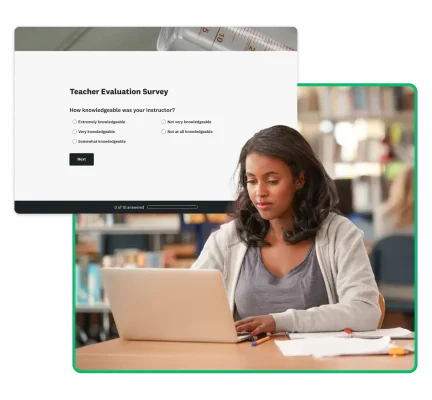How to conduct effective teacher evaluation surveys (with examples)
Learn how to create surveys that students will actually complete and get ready-to-use teacher evaluation templates to simplify the process.

Obtaining honest, high-quality student feedback is an effective way to boost your teaching and a great opportunity to put your growth mindset into practice. Not only do teacher evaluation surveys measure student sentiment about their teachers’ performance, but they also help teachers improve their teaching and close learning gaps.
Below, we’ll consider what a teacher evaluation survey looks like, including why it’s important to get it right. You’ll also learn how teacher evaluation forms can help you improve educational outcomes (and advance your career).
What is a teacher evaluation?
Teacher evaluation is how you measure teacher performance and effectiveness.
Teacher evaluations can be observational, such as when an administrator or peer watches a teacher in their classroom. To complement these observations, teachers and administrators use teacher evaluation surveys to measure and track teacher performance.
For example, a secondary school headteacher may regularly send surveys to students asking for their feedback.
Why evaluate teachers?
You can’t improve teaching quality without first understanding what requires improvement. The goal of teacher evaluations, particularly teacher evaluation questions for students, is to collect insights that can be used to take action.
Prove teaching effectiveness
Teacher evaluation assesses the effectiveness of your teaching so you can repeat successful strategies and rework those that don’t resonate with students.
In fact, a Stanford study found that when teachers were evaluated, their teaching effectiveness improved during that particular academic year and also for years afterwards.
Of course, evaluations can help with more than just student success. The data that you collect can provide evidence of development and advance teachers’ careers. For example, positive student outcomes and teacher evaluations can help teachers achieve promotions and tenure.
Create better student experiences
Identify gaps in tools, support and funding to improve student comprehension and engagement in the classroom. Although test scores are considered powerful indicators of student performance, they don’t always reveal teaching effectiveness. Teacher evaluations can fill in the gaps.
For example, imagine a situation where students scored highly in a specific course but when asked “How well do you understand the class material?”, the majority of them answered “Not very well”. The instructor learns that although they’ve done an excellent job in terms of preparing students for testing, these students need to gain a deeper understanding of the material.
The instructor may need to spend more time and energy helping students to fully grasp concepts and less on rote memorisation.
Identify opportunities for continuing education
Teacher evaluations clarify professional growth needs so you can seek out the right training or resources that fuel your teaching. For example, the administrator of an academic institution may discover from student surveys that classroom materials aren’t always accessible to students with disabilities. Teachers may need extra training to prepare materials that accommodate student needs.
Note: In the UK, continuing professional development is an invaluable aspect of teachers’ work in academic institutions. By regularly updating their knowledge and skills, teachers are much more likely to remain competent, effective and innovative within their role.

14 teacher evaluation survey questions for students
Need some teacher evaluation examples? Here are the top sample questions for teacher evaluation surveys.
- How knowledgeable was your instructor?
- Extremely knowledgeable
- Very knowledgeable
- Somewhat knowledgeable
- Not so knowledgeable
- Not at all knowledgeable
- How clearly did your instructor explain the course material?
- Extremely clearly
- Very clearly
- Somewhat clearly
- Not so clearly
- Not at all clearly
- How would you rate the instructor’s mastery of the material?
- Excellent
- Very good
- Somewhat good
- Not so good
- Not at all good
- How well did your instructor answer students’ questions?
- Extremely well
- Very well
- Somewhat well
- Not so well
- Not at all well
- Was the work for this class too easy, too hard or about right?
- Much too easy
- Too easy
- About right
- Too hard
- Much too hard
- How helpful were the homework assignments to your understanding of the material?
- Extremely helpful
- Very helpful
- Somewhat helpful
- Not so helpful
- Not at all helpful
- How true is the following statement? Throughout this course, I feel I’ve learned a lot about the subject matter.
- Extremely true
- Very true
- Somewhat true
- Not very true
- Not at all true
- How easy was it to approach the instructor with questions or concerns?
- Extremely easy
- Very easy
- Somewhat easy
- Not so easy
- Not at all easy
- How clearly did the instructor provide expectations for the course?
- Extremely clearly
- Very clearly
- Somewhat clearly
- Not so clearly
- Not at all clearly
- How well did the instructor adhere to the syllabus?
- Extremely well
- Very well
- Somewhat well
- Not so well
- Not at all well
- Was the speed at which your instructor presented the course material too fast, too slow or about right?
- Much too fast
- Too fast
- The right speed
- Too slow
- Much too slow
- What was your favourite/least favourite part of the course?
- What did this instructor do to make this class engaging?
- Is there anything else you think your instructor should know?
Note: Questions 12–14 are open-ended, meaning students write their own answers.
Teacher effectiveness questions
These are questions like "How clearly did your instructor explain the course material?” and “How well did your instructor answer students’ questions?” Use the answers to these questions to determine how effective your classroom instruction and coursework were in terms of imparting information.
If your evaluation isn’t anonymous, then you may want to track students’ marks and attendance along with their survey answers. Are students who are frequently absent rating their teacher’s effectiveness poorly? In these cases, encouraging attendance or providing more out-of-class resources may be a simple solution.
Student growth and development questions
Questions assessing how much and how well students learned in your class can give insight into student development. These include questions such as:
- Was the work for this class too easy, too hard or about right?
- How helpful were the homework assignments to your understanding of the material?
- How true is the following statement? “Throughout this course, I feel I’ve learned a lot about the subject matter.”
Consider asking questions about accommodations as well. Students with learning differences or an Individual Education Plan (IEP), or those who are pulled out of the classroom to take part in various activities, may require different accommodations to ensure that they keep up with their peers.
Classroom management questions
Determining how well an instructor manages a classroom requires asking questions such as “What does this teacher do to make this class engaging?” (open-ended) and “Was the speed at which your instructor presented the course material too fast, too slow or about right?” (closed-ended).
Proper classroom management creates an environment where students can learn and grow. Moreover, effective classroom management can also improve teacher retention rates.
According to a RAND study conducted among US state school teachers, “Stress [is] the most common reason for leaving public [state] school teaching early.” A well-managed classroom is efficient and calm, reducing stress for students and teachers alike.
The survey responses to these questions help teachers take a step back and reflect on their management skills, assessing how they feel in the classroom.
5 challenges and limitations of teacher evaluations
Teacher evaluations aren’t a perfect solution. They have some weaknesses that can require workarounds. Here are some common issues to bear in mind and some tips on how to fix them.
1. Some students won’t engage
Some students simply won’t participate in teacher evaluations. They may:
- Mentally check out by the end of a class or term
- Prioritise other studies, especially if evaluations are given out during end-of-year testing
- Not enjoy taking surveys and refuse to complete any
Even making a survey a requirement for the course may backfire. Some students will fill out the survey randomly just to get it completed, and some will resent being forced to participate and give more critical answers than they would otherwise. We recommend accounting for incomplete participation and encouraging students to complete the survey on their own terms.
2. Anonymous vs. named surveys
You must choose between anonymous and named surveys. Both options have their own challenges and perks. A named survey may limit the likelihood of a student answering honestly. Some students may fear judgement or not wish to be contacted for follow-up.
A fully anonymous survey may yield more candid responses and even result in increased student participation. This possible increase in honest data can make anonymous surveys a better option.
However, remember that while a fully anonymous survey may deliver more accurate results, it won’t allow you to identify outliers. For example, you can’t remove responses from students who required disciplinary action or had poor attendance.
3. Lengthy surveys
Comprehensive surveys are designed to capture detailed and actionable feedback, but they may lead to student fatigue. When faced with a long list of questions, students may rush their answers, provide incorrect responses or abandon the survey altogether. This can significantly impair the quality and effectiveness of your data.
To combat this, design your evaluations with key stage level, competency and goals in mind. For example, a key stage 4 student will generally have a shorter attention span than a postgraduate student. Keep your question length and content appropriate for the age and ability of students.
That said, shorter, more focused surveys targeting key teaching practices can encourage more thoughtful and meaningful responses, regardless of age. Ask questions about the aspects of your teaching methods that you are most looking to improve or evaluate. Finally, always prioritise clear and simple question design.
4. Inconsistent evaluation cycles
Some institutions don’t conduct teacher evaluations as consistently or regularly as they should. This makes tracking a teacher’s progress and development challenging over time.
Ideally, you should conduct evaluations for every class session. The evaluations also need to be consistent from one term to the next. If the teacher evaluation questions are changed too much, it becomes difficult to compare performance and identify trends or areas of growth.
5. Inherent bias
According to the US online publication Inside Higher Ed, teacher evaluations may “face concerns about gender bias, including in student evaluations of female professors”. Evaluations may suffer from other forms of bias, including:
- Personal bias: When a student strongly dislikes or likes a teacher due to personal reasons
- Racial bias: The determination of a teacher’s effectiveness based on or influenced by race
- Subject bias: The determination of a teacher’s effectiveness based on the subject matter
To reduce bias, a study published in the US journal article Assessment & Evaluation in Higher Education recommends using a combination of independent evaluators, interviews with students, teaching observations by experts and peer review of instructional materials and survey scores.
How to use teacher evaluation surveys
The best way to find out what students think about your teaching and your course is to ask them, and the easiest way to do that is by using a teacher feedback form.
Sending an evaluation survey to students gives them a voice and can help you identify trends and issues that need your attention.
Ready to start? Here are four steps you can take to gather student feedback via teacher evaluation surveys.
Explain the purpose and goals of the survey
Take the time to discuss why you’re sending this survey to your students. Explain how you’ll look at the data, how you’ll act on it and why you value students’ honesty.
Make sure you expand on your personal teacher goals for evaluation. For example, your wish to improve and help your students improve, too. Be upfront about whether students will have the option to answer the survey anonymously and whether anyone else, such as your head of department or fellow teachers, will be able to see the results.
The Center for Teaching at Vanderbilt University in the USA also suggests mentioning student feedback in your syllabus. This emphasises the fact that feedback is a component of your course and may help students pay closer attention to their experience in your classroom. It also prepares them to answer the teacher feedback survey questions in full when the time comes.
Ask the right questions
How do you know which questions will spark valuable student feedback? Start by considering what you want to get out of your teacher evaluation survey.
- Do you want to gain a better understanding of how students view your teaching style or whether they feel comfortable approaching you with their questions?
- Do you want to dig into the workload, pace and structure of your course and then follow up with questions about your teaching? (Our course evaluation template can help with that.)
Consider what you need to know to enhance your teaching and relationship with your students. To get the most out of your questions, vary your question types and make sure your survey includes some open-ended questions with text boxes for unstructured responses.
For example, our instructor evaluation template asks a series of multiple choice questions. Students are prompted to enter their answers to the last two questions: Are there any aspects of your instructor’s performance that were particularly good? Are there any aspects of your instructor’s performance that could be improved upon?
When you ask students to answer in their own words, you’re giving them an opportunity to address anything your survey may have missed. Nonetheless, make sure that most of your questions are closed-ended. Writing answers takes time and effort and you don’t want to deter busy students from taking your survey.
Look for trends and make data-driven changes
Assessing student feedback can be challenging, so it’s important to approach it with an open mind and keep an eye out for patterns that point to necessary improvements.
For example, if the data shows that 80% of your students found a particular piece of work difficult, you should consider whether an overhaul of the instructions, requirements or introductory lesson is needed.
Set benchmarks for the future
Make your teacher evaluation survey a habit. Send it regularly at the end of a course and consider sending it at the half-way point of each term. By doing so, you can address any issues before the course ends and compare the first set of results with the last. That comparison is important, as it allows you to track your development and set teacher goals for further evaluation.

More teacher evaluation examples and resources
A survey is a great way to complement a comprehensive teacher evaluation. It’s important to remember that teacher evaluations work the other way, too. For example, teachers can assess their students’ readiness for college or university by providing evaluations that support admissions decisions.
Need help getting started on your teacher evaluation survey? Check out our education surveys for additional teacher surveys, as well as these helpful educator resource templates:
Check out all of our customisable education survey templates to get started today. Or learn how SurveyMonkey can help you develop a teacher evaluation rubric, collect student feedback and improve your classroom.
Discover more resources

Solutions for your role
SurveyMonkey can help you do your job better. Discover how to make a bigger impact with winning strategies, products, experiences and more.

Get feedback you can act on with online evaluation forms
Create and customise evaluation forms online. Collect structured feedback, assess performance and make data-driven decisions with ease.

Childcare Registration Form Template
Streamline daycare enrolment with our daycare registration form template. Customise it to your needs with the intuitive SurveyMonkey form builder.

Alumni registration form template
Stay connected with your institution’s alumni with our alumni registration form template. Customise it to your needs with our intuitive form builder.